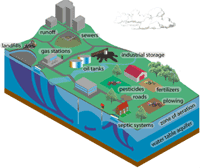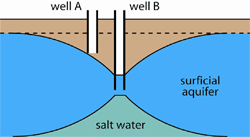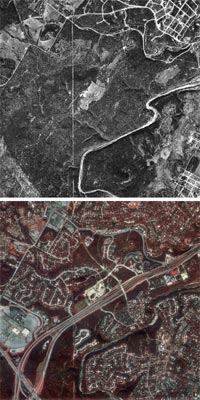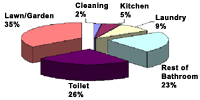People
Groundwater use by purpose
The state of Texas used a total of 16.1 million acre-feet (~5.2 trillion gallons) of water in 2002. Sixty-one percent (10 million acre-feet) of this water is pumped from aquifers. In comparison, only 5.3 million acre-feet per year recharge Texas aquifers (TWDB, 2002).

The population of Texas is rapidly increasing, as is the amount of municipal water being used. However, less of the state is being farmed, so the amount of water used for irrigation, and the total amount being used in Texas is currently decreasing. Unfortunately, reduced levels of irrigation do not translate into more drinking water. Most water used for irrigation are in the Texas panhandle and derived from the very large amount of water in the Ogallala Aquifer; population growth in the state is most drastic in south Texas, where the available aquifers contain many times less water. Further, relying on surface water for human use still impacts groundwater. Water that is diverted for use, or retained in a reservoir cannot recharge an aquifer.
Desalinization may soon add another source of water for Texas. This is not restricted to the vast amounts of seawater but includes much of the groundwater in the state, especially in west Texas. Desalinization is less expensive on waters that began at lower levels of salinity, so brackish groundwater may more economical than water from the Gulf of Mexico
(LBG-G, 2003).

Municipal water use
In most areas, municipal water comes from a combination of surface sources, such as lakes, streams, and rivers, and groundwater. The ends of the spectrum are illustrated by the rates of groundwater use in San Antonio and Dallas. If you live in the San Antonio area, almost 100% of your water comes from an aquifer. In Dallas, only 1% of the water is derived from underground.
References
LBG-G (LBG-Guyton Associates). 2003. Brackish Groundwater Manual for Texas Regional Water Planning Groups. Texas Water Development Board, Austin, Texas, 188 pp.
Sierra Club. 2003. Facts about Texas Water and Simple Steps to Appreciate, Conserve and Protect Our Most Valuable Resource. Lone Star Chapter Sierra Club, Austin, Texas, 25 pp.
TWDB (Texas Water Development Board). 2002. Water for Texas 2002. Texas Water Development Board, Document no. GP-7-1, Austin, Texas, 156 pp.
Sources of contamination
Contamination of groundwater is a serious problem because the pollutants often travel unnoticed until tested. This is especially problematic in karst aquifers because of the rapid movement of contaminants. Once contaminated, an aquifer is difficult to clean and the effects can linger for many years.
- Excess organic matter: farm animal wastes, leaky sewers and septic systems.

- Toxic organic compounds: landfills, gas stations, industrial sites, oil tanks, urban runoff.
The most prevalent groundwater contaminant may be herbicides and pesticides. In a study of aquifers across the U.S., herbicides, and pesticides were detected in about half (Barbash, 2001).
Contamination by nature
Many of the items listed here as contaminants do occur naturally as well. Some are actually necessary to support healthy ecosystems. Organic matter, nitrates, and phosphorous all contribute to the diversity of life associated with groundwater. It is not the simple presence of these items that is problematic, but the excess amounts that pollutes groundwater resources for both human use and natural ecosystems.
Even when all precautions are taken, natural disturbances can impact groundwater quality. Storms can create large amounts of runoff that quickly carry pollutants into water supplies without being filtered. Fires can remove ground cover and cause increased sediment pollution. Landslides and earthquakes can break sewer lines and release contaminants from septic systems, landfills, and underground storage containers.
References
Barbash, J. E., G. P. Thelin, D. W. Kolpin, and R. J. Gilliom. 2001. Major herbicides in ground water: results from the National Water-Quality Assessment. Journal of Environmental Quality 30:831-845.
Overpumpage
Overpumpage occurs when the amount of water being removed from an aquifer exceeds the amount entering the aquifer as recharge. In some cases, this only occurs on a seasonal basis, where aquifers are overpumped during the dry season but have a net gain in water other times. In other cases, overpumpage far exceeds recharge, leading to the loss of the aquifer as a water source.
Hydraulics of overpumpage

When water is pumped out of an aquifer faster than it flows into an area naturally, the surface of the water is lowered. The distance from the water surface to the level of the water table if there was no pumping is called the drawdown. The entire lowered water surface is called the cone of depression; the area of land above the cone of depression is the area of influence. All wells in the area of influence will show a lowered water level, even if they are not pumping. In the extreme case, the cone of depression can be below the reach of another well (Fig. 1).
Salt water intrusion
Seawater naturally extends under land, but because it is denser than freshwater, it is at much greater depths. During pumping, however, the water level is not only changed at the upper surface of the aquifer but also at the lower boundary with the heavier salt water. This can lead to nonpotable salt water being pumped from the well.
Florida, southern California, and New York are some areas in the U.S. where salt water intrusion is particularly problematic, but two-thirds of the conterminous U.S. is underlain by salt water aquifers, so the problem is not limited to coastal areas (Bruington, 1972). Control of salt water intrusion in coastal areas by 1) injecting fresh water between the coast and the production wells, 2) constructing recharge basins seaward of the production wells, and 3) placing pumping wells near the coast and discarding this saline water back into the ocean.
Ground surface subsidence
Permanent subsidence can occur when water stored underground is removed by pumpage or draining. The reduction in fluid pressure in the pores and cracks in unconsolidated rocks allow overlying rocks to compact the sediments, lowering the land surface. Annual costs in the U.S. from flooding and structural damage caused by land subsidence exceeds $125 million (NRC, 1991).
The Houston area, possibly more than any other metropolitan area in the U.S. has been adversely affected by land subsidence, with areas having subsided as much as 9 feet. In Mexico City, subsidence rates approach 2 feet per year in places, and the total subsidence in the 20th century is 30 feet (Galloway et al., 1992).
References
Bruington, A. E. 1972. Saltwater intrusion into aquifers. Water Resources Bulletin 8:150-160.
Galloway, D., D. R. Jones, and S. E. Ingebritsen. 1999. Land subsidence in the United States. US Geological Survey Circular 11821:175.
NRC (National Research Council). 1991. Mitigating losses from land subsidence in the United States. National Academy Press, Washington, D.C., 58 pp.
Impact on city development
Cities have long been built along coasts, rivers, and lakes, where water supplies food and easy transportation. Groundwater upwelling at springs has also drawn settlers to the abundant clean water and animal and plant life. This is especially true in central Texas, where both Native Americans and European immigrants settled along a corridor extending from Salado to Bracketville where water from the Edwards Aquifer feeds numerous streams. Aquarena Springs in San Marcos, is actually the longest continually occupied site in North America, with humans first inhabiting the area 12,000 years ago (Shiner, 1984).

Even though the transportation and food needs of central Texas are no longer so closely tied to springs, the development and growth of cities is still dictated, in part, by groundwater resources. Development within aquifer recharge zones and contributing zones is sometimes restricted or regulated particularly with regard to the amount of impervious cover.
Legal impacts
Because groundwater is “out of sight and out of mind” legal efforts are often required to protect water quality in aquifers. Unfortunately, the complexity of groundwater flow and the potential time-lag between the polluting event and the discovery of the contamination make proving liability for groundwater pollution technically and legally difficult.
Because the rate and amount of pumping of water from wells can impact other wells, lower the water table, and even cause permanent ground subsidence, rules exist concerning groundwater extraction. Unfortunately, these rules vary widely. This leads to significant conflicts when groundwater resources extend beyond state or national boundaries.
Impact on recreation
Beyond the typical uses of groundwater (municipal, agricultural, commercial), aquifers provide numerous recreational activities. Springs feed streams and lakes that are used for fishing, boating, and swimming.
Many of the items listed here as contaminants do occur naturally as well. Some are actually necessary to support healthy ecosystems. Organic matter, nitrates, and phosphorous all contribute to the diversity of life associated with groundwater. It is not the simple presence of these items that is problematic, but the excess amounts that pollutes groundwater resources for both human use and natural ecosystems.
Even when all precautions are taken, natural disturbances can impact groundwater quality. Storms can create large amounts of runoff that quickly carry pollutants into water supplies without being filtered. Fires can remove ground cover and cause increased sediment pollution. Landslides and earthquakes can break sewer lines and release contaminants from septic systems, landfills, and underground storage containers.
References
Shiner, J. L. 1983. Large springs and early American Indians. Plains Anthropologist 28:1-7.
Benefits of water conservation
Conservation of groundwater is primarily driven by the conservation of water generally. Reducing our use of water lightens our environmental burden and ensures a clean supply of water for the future. Further, there are tangible financial benefits to using less water: lower utility bills, rebates offered by utility companies and governments for installation of water-efficient fixtures, and reduced tax burden (for the construction of dams and desalination facilities). If the only change made was to use water-efficient toilets throughout Texas now, they could save 200 million gallons of water each day. This single change would save $3.4 billion over 50 years that would otherwise be spent on water and wastewater treatment plants, and save $200 million on residential water and sewer bills (Jensen, 1991).
Reduce your water use
Inside:

- install water-saving showerheads, efficient toilets, low-flow faucet aerators, and water-efficient washing machines
- check all faucets, pipes, and toilets periodically for leaks and fix any problems immediately
- take a short shower instead of a bath
- turn off the water while brushing teeth
- only run the dishwater and washing machine with a full load
- keep drinking water in the refrigerator instead of running the faucet until it cools
- defrost food in the refrigerator or microwave instead of under running water
Outside:
- adjust irrigation settings to only water in the early morning or late evening to reduce loss to evaporation
- make sure sprinklers do not water the street or sidewalk
- xeriscape – plant drought-resistant plants
- keep the lawn free of weeds
- do not let the water run while washing the car
- cover your swimming pool to reduce evaporation
Recycle eater
- reuse fish tank water to water houseplants (this water also acts as a fertilizer)
- if you drain your pool, use the water to irrigate your lawn
- collect rainwater from your roof for irrigation (or indoor use after filtration)
Educate others about water conservation
Educating others about the importance of conserving water may have the biggest impact. This should not be restricted to just individuals but to businesses, municipal water providers, and local/state policymakers.
References
Jensen, R. 1991. Toilets, showerheads, washing machines and faucets can all use less water. Texas Water Resources 17(4):1-11.
TCPS (Texas Center for Policy Studies). 1995. Texas Enivornmental Almanac. Texas Center for Policy Studies, Austin, Texas, 371 pp.